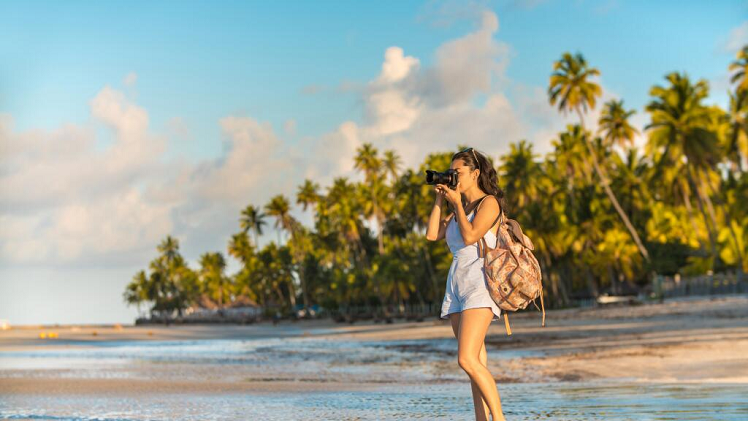Travel Photography Tips: A Complete Guide to Capturing Your Adventures Like a Pro

Travel photography tips are more than just snapping pictures of your surroundings; it’s about telling a story, capturing memories, and preserving the essence of a place. Whether you’re traveling for leisure or as a digital nomad, the ability to take stunning photographs can enhance your experience and create lasting memories. In this comprehensive guide, we will cover essential travel photography tips to help you capture breathtaking images while traveling the world.
From understanding your camera settings to discovering creative composition techniques, these tips will make your travel photos stand out and inspire you to see the world through the lens.
Table of Contents
ToggleWhy Travel Photography is Essential
The Power of Storytelling
Travel photography tips allow you to tell a story about the places you visit and the people you meet. Every photo has the potential to convey emotions, cultures, and landscapes, bringing your journey to life in a way that words alone cannot. Whether it’s a bustling city street, a serene mountain view, or an intimate portrait of a local artisan, your photographs are your unique narrative.
Capturing Memories
Traveling can be overwhelming with so much to see and experience. Photography helps you document your adventure, ensuring that memories remain vivid even years after the trip. Looking at your photos later can transport you back to those moments, reminding you of the incredible people and places you encountered.
Enhancing Your Travel Experience
The act of capturing photographs can deepen your connection to the places you visit. When you actively focus on your surroundings, you become more aware of the details—textures, colors, and light—that make a location unique. This intentionality adds layers of meaning to your travel experience.
Essential Travel Photography Tips for Beginners

For those just starting out in travel photography, it can feel overwhelming, especially when you’re juggling the excitement of exploring a new place with the technicalities of your camera. Here are some basic tips to get you started:
Know Your Camera
Understanding how your camera works is crucial for taking great travel photos. Whether you’re using a DSLR, mirrorless camera, or even a smartphone, knowing your camera’s settings will allow you to adjust for different conditions and get the best results.
Key Camera Settings to Learn:
- Aperture (f-stop): Controls the amount of light entering the camera and the depth of field (blurriness of the background).
- Shutter Speed: Determines how long the camera’s sensor is exposed to light, affecting motion blur.
- ISO: Adjusts the sensitivity of the camera’s sensor to light, allowing you to shoot in low-light environments.
- White Balance: Helps you control the color temperature, ensuring accurate colors in your photos.
Invest in Quality Lenses
While your camera body is important, lenses play a major role in the overall quality of your photos. A good lens can enhance your travel photography, especially when capturing landscapes or portraits.
Recommended Lenses for Travel:
- Wide-Angle Lens: Ideal for landscapes and architecture shots.
- Zoom Lens: Great for capturing distant subjects without physically moving closer.
- Prime Lens: offers sharper image quality and better low-light performance.
Use Natural Light to Your Advantage
One of the best tools in your photography kit is natural light. It creates a more organic, softer look in your photos. Golden hour—just after sunrise and before sunset—is ideal for capturing the warm glow that enhances almost any scene.
How to Make the Most of Natural Light:
- Golden Hour: Shoot during the first hour after sunrise or the last hour before sunset to capture soft, warm light.
- Avoid Harsh Midday Sun: The bright midday sun can cast harsh shadows. Instead, find shaded areas or shoot in the morning/evening.
- Backlighting: Experiment with backlighting (light coming from behind your subject) to create a silhouette effect.
Advanced Travel Photography Techniques
Once you’ve mastered the basics, you can explore more advanced techniques to take your travel photography to the next level.
Rule of Thirds and Composition
Composition is the key to creating visually compelling images. The rule of thirds is one of the most basic yet effective techniques for framing your subject.
How to Use the Rule of Thirds:
Imagine dividing your frame into a 3×3 grid. Place your subject along the lines or at the intersections to create a more balanced and dynamic composition. For example:
- Position a landmark on one of the vertical lines, leaving space for the surrounding landscape.
- In portraits, align the subject’s eyes with the top horizontal line for a more engaging photo.
Leading Lines and Framing
Leading lines naturally guide the viewer’s eye toward the focal point of the image. Use roads, rivers, or architectural features like bridges and staircases to create a sense of depth and movement in your travel photos.
Framing: Another technique that enhances composition is framing—using elements in the scene, such as doorways, windows, or trees, to frame your subject and create a sense of intimacy.
Experiment with Long Exposure Photography
Long exposure photography is a technique where you leave the shutter open for an extended period, resulting in motion blur. This is particularly effective for capturing flowing waterfalls, bustling city streets, or night photography with light trails.
How to Achieve Long Exposure:
- Use a tripod to prevent camera shake.
- Set a low ISO and adjust your shutter speed to control the amount of time the shutter remains open.
- For day-time long exposure, consider using a neutral density (ND) filter to reduce the light entering the lens.
Top Tips for Capturing Different Travel Environments
Each environment you encounter while traveling offers its own unique challenges and opportunities for photography. Here are some specialized tips for capturing specific types of scenes:
Landscape Photography
Landscapes can be some of the most breathtaking subjects for photography, but they require attention to detail and proper composition to truly shine.
Landscape Photography Tips:
- Use a Tripod: A steady tripod is crucial for sharp images, especially when shooting at lower shutter speeds.
- Focus on the Foreground: Include interesting elements in the foreground (rocks, plants) to create depth in the photo.
- Capture the Sky: Include dramatic skies with clouds, sunrises, or sunsets to add mood to your landscape shots.
Urban and Street Photography
Urban environments provide endless opportunities for dynamic photography, from busy streets to architectural marvels. Street photography is about capturing candid moments of life in the city.
Street Photography Tips:
- Focus on People: Candid shots of locals help tell the story of a place.
- Look for contrast: High contrasts between light and shadow can make your street photos more striking.
- Be Discreet: Respect people’s privacy by being subtle with your camera and blending in with the environment.
Wildlife and Animal Photography
Wildlife photography requires patience and a good understanding of your subject. Whether photographing safari animals, birds, or domestic animals, the key is to get close while respecting the animals’ space.
Wildlife Photography Tips:
- Use a Telephoto Lens: A long lens allows you to capture animals without disturbing them.
- Shoot in Continuous Mode: This helps you capture multiple frames in quick succession, especially when animals are moving.
- Be Patient: Animals can be unpredictable, so patience is key to capturing great shots.
Post-Processing: Enhancing Your Travel Photos
While it’s always best to capture the best possible image in camera, post-processing can significantly enhance your photos. Here are some editing tips to make your travel photos pop:
Adjust Exposure and Contrast
Fine-tune the exposure and contrast of your images to bring out the best in your photos. Increase contrast to make the colors more vivid and adjust exposure to correct any overexposed or underexposed areas.
Enhance Colors and Details
Using software like Adobe Lightroom or Snapseed, adjust the vibrance and saturation to make the colors in your images more vibrant. Sharpening details and increasing clarity will bring out fine textures, making landscapes and portraits more impactful.
Crop and Straighten
Cropping is an essential part of composition. Crop your image to improve framing, eliminate distractions, or apply the rule of thirds. Also, use the straightening tool to correct any horizon lines that appear tilted in your photos.
Conclusion: Mastering the Art of Travel Photography
Travel photography is a powerful way to document your adventures and share your experiences with others. By understanding your camera, experimenting with creative techniques, and refining your skills through practice, you can capture stunning photos that will last a lifetime. Whether you’re a seasoned photographer or a beginner, the tips in this guide will help you elevate your travel photos and make your journey even more memorable.
Remember, great travel photos are not just about the equipment you use—they’re about seeing the world through a unique lens, telling a story, and capturing moments that matter.
This article has covered a broad range of travel photography tips, from the basics of camera settings to advanced techniques for capturing everything from landscapes


